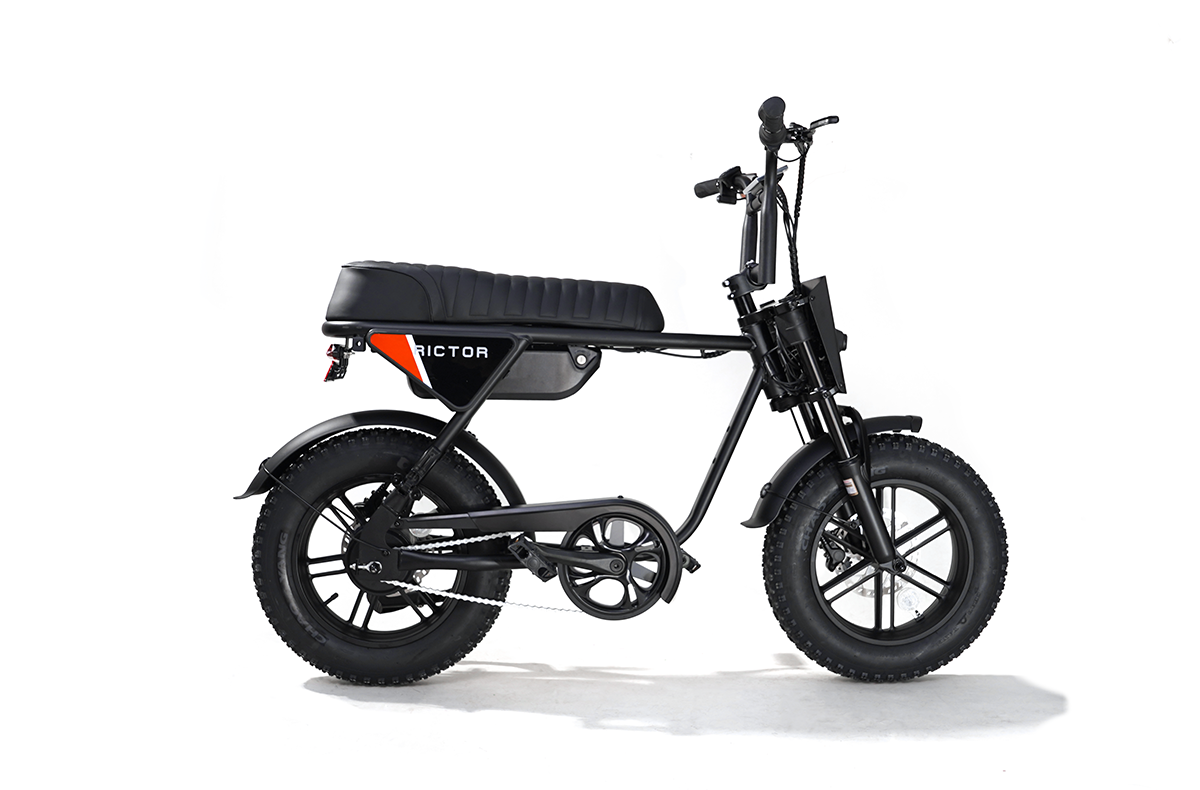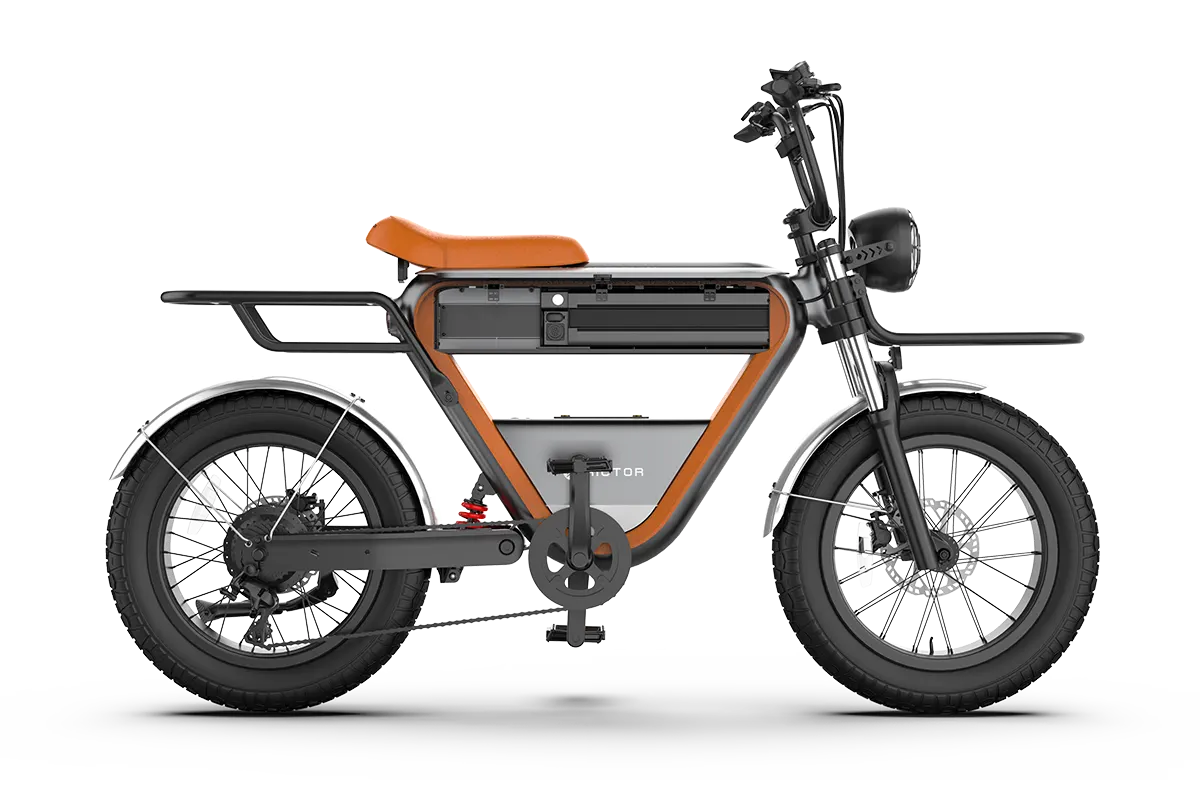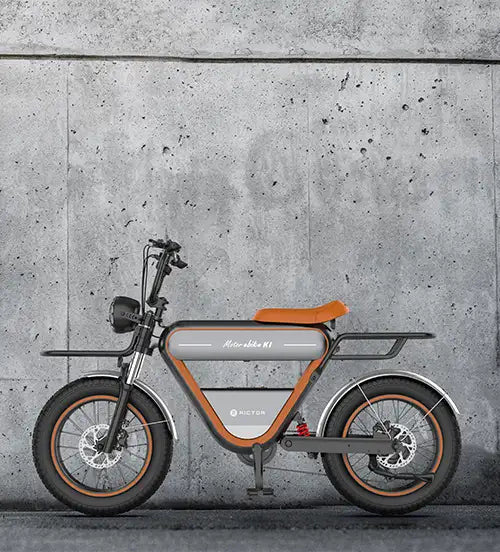
Electric Bike Kit | PAS Sensor Explained
PAS stands for Pedal Assist System. In electric bikes, it's a simple device that notices when you're pedaling and tells the motor to help you out.
This makes your electric bike ride smoother and less tiring, especially on hills or long trips.
The main job of a PAS sensor in an electric bike is to make riding easy and natural.
By sensing your pedaling, it ensures the motor only kicks in when you need it.
You don't have to use a throttle manually—just pedal, and the electric bike does the rest. It's like always having a gentle push helping you move forward.
How PAS Sensors Work
A Pedal Assist System (PAS) sensor primarily consists of two parts: a magnetic disc and a sensor unit.
The magnetic disc is mounted on the crank arm or pedal axle and is embedded with several small magnets arranged in a circular pattern.
The sensor unit, positioned close to this disc, contains a Hall-effect sensor or an optical sensor.
As you pedal, the magnetic disc rotates, and the magnets pass by the sensor unit.
This movement generates signals that the sensor detects.
The interaction between the rotating magnets and the stationary sensor is the key to how the system knows you're pedaling.
How Does a PAS Sensor Operate
When you start pedaling, the magnetic disc spins, causing the magnets to move past the sensor unit.
Each passing magnet triggers the sensor, which sends signals to the e-bike's controller—the system's central processor.
The controller interprets these signals to determine your pedaling speed and cadence (the rate at which you're pedaling).
Based on this information, the controller adjusts the motor's output to provide the appropriate level of assistance.
The faster you pedal, the more frequent the signals, resulting in increased motor support.
This mechanism ensures that motor assistance is synchronized with your pedaling efforts, offering a smooth and responsive riding experience.

How Sensitive Is the PAS Sensor to Pedaling
The sensitivity of a PAS sensor depends on several factors:
-
Number of Magnets: A disc with more magnets can detect pedaling motion more quickly. A disc with 12 magnets offers faster response times than one with 5 magnets, as the sensor receives signals more frequently.
-
Type of Sensor: Some PAS systems use torque sensors instead of standard cadence sensors. Torque sensors measure the force you're applying to the pedals, allowing for more precise motor assistance based on your actual effort.
-
Placement and Alignment: Proper alignment between the magnetic disc and the sensor unit is crucial. If they are misaligned or too far apart, the sensor may not accurately detect the magnets, leading to delayed or inconsistent assistance.
A highly sensitive PAS sensor provides immediate motor engagement with minimal pedal movement, enhancing the overall riding experience.
Less sensitive sensors might require a full pedal rotation before activating the motor, which could be noticeable when starting from a complete stop or when navigating steep inclines.
SEE ALSO Is 48V Enough Power for Your Electric Bike?
Installation and Compatibility
Installing a PAS sensor yourself is generally a feasible task, even if you're not an experienced bike mechanic.
Most electrical bike kits come with the necessary components and detailed instructions to guide you through the process. Here's how you can do it:
-
Gather Necessary Tools: You'll need basic tools such as Allen wrenches, screwdrivers, and possibly a crank puller.
-
Remove the Crank Arm: Begin by removing the crank arm on the side where the PAS sensor will be installed. This usually involves loosening the bolts that hold the crank in place and gently pulling it off the spindle.
-
Install the Magnetic Disc: Slide the magnetic disc onto the spindle or attach it to the crank arm, following the manufacturer's instructions. Ensure the magnets are facing the correct direction for the sensor to read them properly.
-
Mount the Sensor Unit: Attach the sensor unit to the bike frame, positioning it close to the magnetic disc. Proper alignment is crucial for accurate detection of the magnets as they pass by the sensor.
-
Connect the Wiring: Route the sensor's wiring along the frame to the controller unit, securing it with zip ties to prevent any interference with moving parts. Connect the wiring as per the instructions.
-
Reattach the Crank Arm: Once the magnetic disc and sensor are in place, reattach the crank arm securely.
-
Test the System: After installation, test the PAS sensor by lifting the bike and spinning the pedals. If the motor engages smoothly, you've successfully installed the sensor.
While the installation is straightforward, take your time to ensure each step is completed correctly.
Do All E-Bike Kits Come with a PAS Sensor
Not all e-bike kits include a PAS sensor. Some kits rely solely on a throttle mechanism for motor control.
Throttle-based systems allow you to control the motor's power manually, without the need to pedal—similar to operating a scooter or motorcycle.
If you prefer the pedal-assist experience, which many riders find more natural and engaging, you'll want to choose an e-bike kit that includes a PAS sensor.
Pedal-assist systems provide motor assistance in response to your pedaling, offering a smoother integration of power that enhances the overall riding experience.
Before purchasing an e-bike kit, review the included components carefully. Manufacturers often list whether a PAS sensor is part of the package.
If it's not included but you desire pedal assistance, check if the kit is compatible with a PAS sensor that can be purchased separately.
Can You Ride an E-Bike Without a PAS Sensor
You can ride an e-bike without a PAS sensor if the bike is equipped with a throttle.
The throttle allows you to activate the motor's assistance manually by twisting a grip or pressing a lever, providing power on demand without the need to pedal.
Riding without a PAS sensor means missing out on the intuitive and energy-efficient benefits of pedal assistance.
With a PAS sensor, the motor support synchronizes with your pedaling effort, resulting in a more seamless and natural ride.
This setup encourages consistent pedaling, which can be beneficial for exercise and overall bike handling.

Impact on Electrical Bike Performance
A PAS sensor elevates your e-bike's performance by synchronizing motor assistance with your pedaling efforts.
Smooth Acceleration
As soon as you start pedaling, the PAS sensor kicks the motor into gear in harmony with your movements. No sudden jolts or delays—just a seamless boost that feels natural. It's like your bike can read your mind (or at least your feet)!
Easier Hill Climbing
Hills won't know what hit them. The sensor detects when you're putting in more effort to conquer an incline and signals the motor to provide extra power. Suddenly, steep climbs feel more like gentle slopes. Who said you can't defy gravity?
Reduced Fatigue on Long Rides
Planning a long journey? The PAS sensor has your back (and legs). By providing consistent assistance, it takes some of the load off your muscles, so you can ride longer without feeling like you've just run a marathon.
Efficient Battery Usage
Since the motor only engages when you're pedaling, you're not wasting energy when coasting or stopped. This intelligent use of power means your battery lasts longer compared to constant throttle use. More miles, more smiles!
Enhanced Riding Experience: The pedal-assist system makes your ride feel more intuitive and connected. No need to fiddle with throttles or buttons—just pedal and go. It's biking, but with a touch of superpower.
PAS Sensors vs. Throttles
PAS sensors and throttles are two distinct methods for controlling electric assistance on your e-bike:
-
PAS Sensor (Pedal Assist System): Activates motor assistance automatically when you pedal. The motor's support is directly linked to your pedaling effort, providing a seamless and natural riding experience.
-
Throttle: Allows you to control the motor's power manually without the need to pedal. By twisting a grip or pressing a lever, you can engage the motor, similar to operating a scooter or motorcycle.
Key Differences
-
Engagement: With a PAS sensor, the motor only assists when you're pedaling. A throttle lets you activate the motor at any time, regardless of whether you're pedaling.
-
Riding Experience: PAS offers a cycling experience that feels traditional but with added assistance. The throttle provides the option to ride without pedaling, offering a different kind of convenience.
-
Control: PAS adjusts the level of assistance based on your pedaling cadence and effort. Throttles give you direct, manual control over how much power the motor provides at any moment.
-
Legal Considerations: In some regions, e-bikes with throttles face stricter regulations or are categorized differently than pedal-assist bikes. It's important to be aware of local laws regarding e-bike classifications.
Benefits of Using a PAS Sensor
Using a PAS sensor brings several advantages to your e-biking experience:
-
Natural Riding Feel: Since motor assistance is tied to your pedaling, the ride feels more like traditional cycling but with an extra boost. This seamless integration enhances overall enjoyment.
-
Improved Battery Efficiency: The motor only engages when you're pedaling, which can lead to more efficient energy use and longer battery life compared to constant throttle use.
-
Regulatory Compliance: Many areas have regulations that favor pedal-assist e-bikes over throttle-controlled ones. Using a PAS sensor can make it easier to comply with local laws, allowing you access to more trails and bike paths.
-
Enhanced Control and Safety: The motor responds to your pedaling input, reducing the chance of unexpected acceleration. This can make for a smoother and safer ride, especially in crowded or urban environments.
-
Exercise Benefits: While you receive assistance, you're still actively pedaling, which can contribute to your overall fitness without overexerting yourself.
By choosing a PAS sensor, you enhance your e-bike with a system that complements your natural cycling motion, offers efficient energy use, and aligns with regulations in many regions.
It provides a balanced approach to electric biking that many riders find rewarding and enjoyable.
How to Troubleshoot a Faulty PAS Sensor
Having trouble with your PAS sensor? Don't worry—getting it back in working order might be simpler than you think. Here's a step-by-step guide to help you troubleshoot the issue:
-
Check All Connections: Start by examining all the electrical connections between the PAS sensor, the controller, and the display unit. Loose or disconnected wires are common culprits. Make sure all plugs are securely connected and free from damage or corrosion.
-
Inspect the Sensor and Magnetic Disc: Take a close look at the PAS sensor and the magnetic disc attached to your crank arm or pedal axle. Look for any visible damage like cracks, broken magnets, or signs of wear and tear. A damaged magnetic disc can't send proper signals to the sensor.
-
Ensure Proper Alignment: The sensor and magnetic disc need to be correctly aligned for the system to work. The sensor should be positioned close enough to the magnetic disc—usually just a few millimeters away—without touching it. If they're misaligned, the sensor might not detect the magnets as they pass by. Adjust the position if necessary to ensure they're properly aligned.
-
Clean the Sensor Area: Dirt, mud, or debris can interfere with the sensor's ability to detect the magnets. Gently clean both the sensor and the magnetic disc with a soft cloth to remove any buildup. Sometimes, a simple cleaning is all it takes to restore functionality.
-
Test the Sensor's Functionality: Lift the bike so the rear wheel is off the ground (you can use a bike stand or have someone help you). Turn on your e-bike system and slowly rotate the pedals by hand. If the motor engages as you pedal, the sensor is working. If not, there's still some detective work to do.
-
Check for Error Codes: Some e-bike systems display error codes on the dashboard or display unit when there's a problem. Refer to your user manual to interpret any codes you see—they can provide valuable clues about what's going wrong.
-
Inspect Wiring for Damage: Follow the wiring from the PAS sensor to the controller. Look for any signs of damage like frayed wires, cuts, or pinch points where the wire might be compressed. Damaged wiring can prevent signals from reaching the controller.
-
Reset the System: Sometimes, electronics just need a good old-fashioned reboot. Turn off your e-bike completely, wait a few minutes, and then turn it back on. This can reset the controller and resolve minor glitches.
-
Update Firmware (If Applicable): If your e-bike system allows for firmware updates, check if there's an update available. Manufacturers occasionally release updates that fix bugs or improve sensor compatibility.
-
Consider Component Replacement: If you've tried everything and the sensor still isn't working, the sensor or magnetic disc might be defective. Replacing the PAS sensor is often straightforward and not too costly. Make sure to get a compatible model for your e-bike system.
-
Seek Professional Assistance: If all else fails, it might be time to consult a professional e-bike technician. They have the tools and expertise to diagnose and fix issues that can be tricky to handle on your own.
🚴♂️Safety Tip: Always disconnect the battery before working on your e-bike's electrical components to prevent any risk of electric shock or damage to the system.
Conclusion
PAS sensor works can greatly improve your electric bike experience. It offers smoother rides and a more natural feel as you pedal along. Whether you're climbing hills or going on long trips, a PAS sensor makes your journey easier and more enjoyable.
If you're interested in experiencing these benefits firsthand, check out RICTOR's electric bikes. They come equipped with high-quality PAS technology, providing you with a seamless and efficient ride.
FAQs
How do weather conditions affect PAS sensors?
PAS sensors are generally designed to withstand typical weather conditions like light rain and dust. However, extreme weather such as heavy rain, snow, or muddy conditions can affect their performance. It's a good idea to keep the sensor and magnetic disc clean and dry to ensure optimal functionality.
Are PAS sensors compatible with all types of e-bikes?
Most PAS sensors are compatible with standard e-bike setups, but compatibility can vary based on the motor system and controller. It's important to verify that the PAS sensor you're considering is compatible with your specific e-bike model and its components.
How long does a PAS sensor typically last?
The lifespan of a PAS sensor depends on factors like build quality, usage frequency, and environmental conditions. Generally, a good-quality PAS sensor can last several years. Regular maintenance, such as cleaning and inspecting for damage, can help extend its life.
💡 Explore More Here!
- How Fast Can E-Bikes with Different Voltages Go?
- Are Electric Bikes Allowed in National Forests? (In Some, Yes)
- Quick Gearshift Tips! Easy Guide for Beginners on 7 Speed Bikes
- 2024 Electric Bicycle Pricing, don’t overpay on your next ride [+ Good Recommendation]
- Beyond the Basics | How Fast Can Your Electric Bike Really Go?




